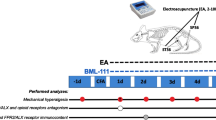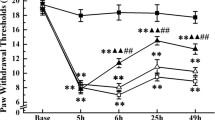Abstract
Complex regional pain syndrome (CRPS) is a disorder that involves abnormal inflammation and nerve dysfunction frequently resistant to a broad range of treatments. Peripheral nerve stimulation with electroacupuncture (EA) has been widely used in different clinical conditions to control pain and inflammation; however, the use of EA in the treatment of CRPS is under investigation. In this study, we explore the effects of EA on hyperalgesia and edema induced in an animal model of chronic post-ischemia pain (CPIP model) and the possible involvement of endothelin receptor type B (ETB) in this effect. Female Swiss mice were subjected to 3 h hind paw ischemia/reperfusion CPIP model. EA treatment produced time-dependent inhibition of mechanical and cold hyperalgesia, as well as edema in CPIP mice. Peripheral administration (i.pl.) of BQ-788 (10 nmol), an ETB antagonist, prevented EA-induced antihyperalgesia while intrathecal administration prolonged EA’s effect. Additionally, peripheral pre-treatment with sarafotoxin (SRTX S6c, 30 pmol, ETB agonist) increased EA anti-hyperalgesic effect. Furthermore, the expression of peripheral ETB receptors was increased after EA treatments, as measured by western blot. These results may suggest that EA’s analgesic effect is synergic with ETB receptor activation in the periphery, as well as central (spinal cord) ETB receptor blockade. These data support the use of EA as a nonpharmacological approach for the management of CRPS-I, in an adjuvant manner to ETB receptor targeting drugs.









Similar content being viewed by others
Change history
13 September 2018
The original version of this article contains an error. The Author Francisco José Cidral-Filho incorrectly listed as Francisco José Cidra-Filho. The correct spelling is presented above. The original article has been corrected.
References
Almeida RT, Duarte ID (2008) Nitric oxide/cGMP pathway mediates orofacial antinociception induced by electroacupuncture at the ST36 acupoint. Brain Res 10:54–60
Almeida RT, Galdino G, Perez AC, Silva G, Romero TR, Duarte ID (2017) ST36 electroacupuncture activates nNOS, iNOS and ATP-sensitive potassium channels to promote orofacial antinociception in rats. J Physiol Pharmacol 68:27–33
Barrett KE, Barman SM, Boitano S, Heddwen LB (2014) Medical physiology of Ganong, 24th edn. Porto Alegre, AMGH
Bridges D, Thompson SW, Rice AS (2001) Mechanisms of neuropathic pain. Br J Anaesth 87:12–26
Carducci MA, Jimeno A (2006) Targeting bone metastasis in prostate cancer with endothelin receptor antagonists. Clin Canc Res 12(Suppl 1):6296–6300
Coderre TJ, Xanthos DN, Francis L, Bennett GJ (2004) Chronic post-ischemia pain (CPIP) - a novel animal model of complex regional pain syndrome-type I (CRPS-I; reflex sympathetic dystrophy) produced by prolonged hindpaw ischemia and reperfusion in the rat. Pain 112:94–105
Desantana JM, Da Silva LF, Sluka KA (2010) Cholecystokinin receptors mediate tolerance to the analgesic effect of TENS in arthritic rats. Pain 148:84–93
Erthal V, Maria-Ferreira D, Werner MF, Baggio CH, Nohama P (2016) Anti-inflammatory effect of laser acupunture in ST36 (Zusanli) acupoint in mouse paw edema. Lasers Med Sci 31:315–322
Ferreira SH, Romitelli M, De Nucci G (1989) Endothelin-1 participation in overt and inflammatory pain. J Cardiovasc Pharmacol 13:220–222
Gay A, Parratte S, Salazard B, Guinard D, Pham T, Legré R, Roll JP (2007) Proprioceptive feedback enhancement induced by vibratory stimulation in complex regional pain syndrome type I - an open comparative pilot study in 11 patients. Joint Bone Spine 74:461–466
Ghoneim MA, Yamamoto T, Hirose S, Nagasawa T, Hagiwara H (1993) Endothelium localization of ETB receptor revealed by immunohistochemistry. J Cardiovasc Pharmacol 22(Suppl 1):111–112
Gim GT, Lee JH, Park E, Sung YH, Kim CJ, Hwang WW, Chu JP, Min BI (2011) Electroacupuncture attenuates mechanical and warm allodynia through suppression of spinal glial activation in a rat model of neuropathic pain. Brain Res Bull 86:403–411
Hans G, Deseure K, Adriaensen H (2008) Endothelin-1-induced pain and hyperalgesia—a review of pathophysiology, clinical manifestations and future therapeutic options. Neuropeptides 42:119–132
Huang C, Hu ZP, Jiang SZ, Li HT, Han JS, Wan Y (2007) CCK(B) receptor antagonist L365, 260 potentiates the efficacy to and reverses chronic tolerance to electroacupuncture-induced analgesia in mice. Brain Res Bull 71:447–451
Huang CP, Chen HN, Su HL, Hsieh CL, Chen WH, Lai ZR, Lin YW (2013) Electroacupuncture reduces carrageenan- and CFA-induced inflammatory pain accompanied by changing the expression of Nav1.7 and Nav1.8, rather than Nav1.9, in mice dorsal root ganglia. Evid based complement alternat med 1-8
Hung VK, Chen SM, Tai LW, Chen AY, Chung SK, Cheung CW (2012) Over- expression of endothelin-1 in astrocytes, but not endothelial cells, ameliorates inflammatory pain response after formalin injection. Life Sci 91:618–622
Hung VK, Tai LW, Qiu Q, Luo X, Wong KL, Chung SK, Cheung CW (2014) Over-expression of astrocytic ET-1 attenuates neuropathic pain by inhibition of ERK1/2 and Akt(s) via activation of ETA receptor. Mol Cell Neurosci 60:26–35
Jr Verri WA, Cunha TM, Parada CA, Wei XQ, Ferreira SH, Liew FY, Cunha FQ (2006) IL-15 mediates immune inflammatory hypernociception by triggering a sequential release of IFN-gamma, endothelin, and prostaglandin. Proc Natl Acad Sci U S A 103:9721–9725
Khodorova A, Navarro B, Jouaville LS, Murphy JE, Rice FL, Mazurkiewicz JE, Long-Woodward D, Stoffel M, Strichartz GR, Yukhananov R, Davar G (2003) Endothelin-B receptor activation triggers and endogenous analgesic cascade at sites of peripheral injury. Nat Med 9:1055–1061
Khodorova A, Montmayeur JP, Strichartz G (2009) Endothelin receptors and pain. J Pain 10:2–28
Kim HW, Uh DK, Yoon SY, Roh DH, Kwon YB, Han HJ, Lee HJ, Beitz AJ, Lee JH (2008) Low-frequency electroacupuncture suppresses carrageenan-induced paw inflammation in mice via sympathetic post-ganglionic neurons, while high-frequency EA suppression is mediated by the sympathoadrenal medullary axis. Brain Res Bull 75:698–705
Kim YO, Kim IJ, Yoon MH (2015) Antiallodynic effect through spinal endothelin-B receptor antagonism in rat models of complex regional pain syndrome. Neurosci Lett 584:45–49
Koo ST, Lim KS, Chung K, Ju H, Chung JM (2008) Electroacupuncture-induced analgesia in a rat model of ankle sprain pain is mediated by spinal alpha-adrenoceptors. Pain 135:11–19
Laferrière A, Millecamps M, Xanthos DN, Xiao WH, Siau C, de Mos M, Sachot C, Ragavendran JV, Huygen FJ, Bennett GJ, Coderre TJ (2008) Cutaneous tactille allodynia associated with microvascular dysfunction in muscle. Mol Pain 4:1–11
Lau WK, Lau YM, Zhang HQ, Wong SC, Bian ZX (2010) Electroacupuncture versus celecoxib for neuropathic pain in rat SNL model. Neurosc 170:655–661
Liang Y, Fang JQ, Du JY, Fang JF (2012) Effect of electroacupuncture on activation of p38MAPK in spinal dorsal horn in rats with complete Freund’s adjuvant-induced inflammatory pain. Evid based complement Alternat Med 12:1–6
Martins DF, Emer AA, Batisti AP, Donatello N, Carlesso MG, Mazzardo-Martins L, Venzke D, Micke GA, Pizzolatti MG, Piovezan AP, dos Santos AR (2015) Inhalation of Cedrus atlantica essential oil alleviates pain behavior through activation of descending pain modulation pathways in a mouse model of postoperative pain. J Ethnopharmacol 175:30–38
Mayor D (2013) An exploratory review of the electroacupuncture literature: clinical applications and endorphin mechanisms. Acupunct Med 31:409–415
Medeiros MA, Canteras NS, Suchecki D, Mello LE (2003) C-Fos expression induced by electroacupuncture at the Zusanli point in rats submitted to repeated immobilization. Braz J Med Biol Resear 36:1673–1684
Midbari A, Suzan E, Adler T, Melamed E, Norman D, Vulfsons S, Eisenberg E (2016) Amputation in patients with complex regional pain syndrome—a comparative study between amputees and non-amputees with intractable disease. Bone Join J 98:548–554
Millecamps M, Laferrière A, Ragavendran JV, Stone LS, Coderre TJ (2010) Role of peripheral endothelin receptors in an animal model of complex regional pain syndrome type 1 (CRPS-I). Pain 151:174–183
Moré AO, Cidral-Filho FJ, Mazzardo-Martins L, Martins DF, Nascimento FP, Li SM, Santos AR (2013) Caffeine at moderate doses can inhibit acupuncture-induced analgesia in a mouse model of postoperative pain. J Caff Reser 3:143–148
Moura D (2011) Use of infrared thermography in the analysis of horse thermoregulation in training. Eng Agric 31:23–32
Oerlemans HM, Oostendorp RA, de Boo T, Goris RJ (1999) Pain and reduced mobility in complex regional pain syndrome I—outcome of a prospective randomised controlled clinical trial of adjuvant physical therapy versus occupational therapy. Pain 83:77–83
Piovezan AP, D'Orléans-Juste P, Souza GE, Rae GA (2000) Endothelin-1-induced ET(A) receptor-mediated nociception, hyperalgesia and edema in the mouse hind-paw: modulation by simultaneous ET(B) receptor activation. Br J Pharmacol 129:961–968
Rodrigues AL, da Silva GL, Mateussi AS, Fernandes ES, Miguel OG, Yunes RA, Calixto JB, Santos AR (2002) Involvement of monoaminergic system in the antidepressant-like effect of the hydroalcoholic extract of Siphocampylus verticillatus. Life Sci 70:1347–1358
Sakurai-Yamashita Y, Yamashita K, Yoshida A, Obana M, Takada K, Shibaguchi H, Shigematsu K, Niwa M, Taniyama K (1997) Rat peritoneal macrophages express endothelin ET(B) but not endothelin ET(A) receptors. Eur J Pharmacol 338:199–203
Shetty SS, Okada T, Webb RL, DelGrande D, Lappe RW (1993) Functionally distinct endothelin B receptors in vascular endothelium and smooth muscle. Biochem Biophys Res Commun 191:459–464
Tang C, Li J, Tai WL, Yao W, Zhao B, Hong J, Shi S, Wang S, Xia Z (2017) Sex diferences in complex regional pain syndrome type–I (CRPS-I) in mice. J. Pain Res 10:1811–1819
Tian JH, Zhang W, Fang Y, Xu W, Grandy DK, Han JS (1998) Endogenous orphanin FQ: evidence for a role in the modulation of electroacupuncture analgesia and the development of tolerance to analgesia produced by morphine and electroacupuncture. Br J Pharmacol 124:21–26
Treuting PM, Dintzis S (2011) Comparative anatomy and histology: a mouse and human atlas (expert consult), 1th ed. Academic Press
Uolla L, Quiroz-Gonazalez S, Torres-Rosas R (2017) Nerve stimulation—immunomodulation and control of inflammation. Trends Mol Med 23:1103–1120
Vural SP, Yuzer GFN, Ozcan DS, Ozbudak SD, Ozgirgin N (2016) Effects of mirror therapy in stroke patients with complex regional pain syndrome type 1- a randomized controlled study. Arch Phys Med Rehabil 97:575–581
Yin CS, Jeong HS, Park HJ, Baik Y, Yoon MH, Choi CB, Koh HG (2008) A proposed transpositional acupoint system in a mouse and rat model. Res Vet Sci 84:159–165
Zhang R, Lao L, Ren K, Berman BM (2014) Mechanisms of acupuncture-electroacupuncture on persistent pain. Anesthesiol 120:482–503
Zhang WP, Onose Y, Fujikawa T (2017) A trial study of moxibustion with a warming needle on edema. J Acupunct Meridian Stud 10:20–25
Zhao ZQ (2008) Neural mechanism underlying acupunture analgesia. Prog Neurobiol 85:355–375
Zhao YD, Springall DR, Wharton J, Polak JM (1991) Autoradiographic localization of endothelin-1 binding sites in porcine skin. J Invest Dermatol 96:152–154
Funding
The present study was supported by grants from Universidade do Sul de Santa Catarina—Curso de Medicina and Programa Unisul de Iniciação Científica (PUIC), Coordenação de Aperfeiçoamento de Pessoal de Nível Superior (CAPES), Conselho Nacional de Desenvolvimento Científico e Tecnológico (CNPq - 476454/2013-1), and Fundação de Amparo à Pesquisa e Inovação do Estado de Santa Catarina (FAPESC-3414/2012), Brazil.
Author information
Authors and Affiliations
Corresponding author
Ethics declarations
Conflict of interest
The authors declare that they have no conflict of interest.
Additional information
The original version of this article was revised: The Author Francisco José Cidral-Filho incorrectly listed as Francisco José Cidra-Filho. The correct spelling is presented above.
Electronic supplementary material
Figure S1
EA does not affect locomotive activity. Effect of cumulative treatment with EA from day 7 to 14 after IR upon locomotive activity. Data were expressed as mean ± standard deviation (SD) (n = 8 animals). EA: electroacupuncture; IR: ischemia and reperfusion. (JPG 120 kb)
Rights and permissions
About this article
Cite this article
Mazzardo-Martins, L., Salm, D.C., Winkelmann-Duarte, E.C. et al. Electroacupuncture induces antihyperalgesic effect through endothelin-B receptor in the chronic phase of a mouse model of complex regional pain syndrome type I. Pflugers Arch - Eur J Physiol 470, 1815–1827 (2018). https://doi.org/10.1007/s00424-018-2192-2
Received:
Revised:
Accepted:
Published:
Issue Date:
DOI: https://doi.org/10.1007/s00424-018-2192-2




